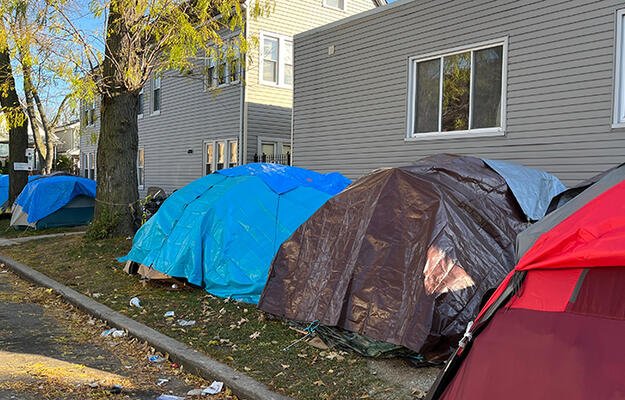
Blue Rhino Media/Shutterstock
Tiered Supports Offer Landlords a Cost-Effective Way to Help Vulnerable Tenants during the COVID-19 Pandemic
For the past nine months, renters have experienced dual health and economic crises brought on by the COVID-19 pandemic. Many have applied for unemployment benefits for the first time, and others are experiencing social isolation and food insecurity. The second coronavirus relief bill, passed in December, offers much-needed stimulus checks and rental assistance and extends unemployment benefits. And President Biden’s recent Executive Order extends the eviction moratorium passed by the Centers for Disease Control and Prevention through March. Yet renters are still struggling to make ends meet and are at risk of losing their homes.
Landlords—particularly small-property owners with fewer than 10 units—are also struggling. A recent survey of mom-and-pop landlords indicates 35 percent of respondents were unable to collect full rent in September because of vacancies and nonpayment of rent. Though property owners are generally facing less severe challenges than low-income renters, the pandemic has nonetheless hit them hard.
Property owners benefit when their residents are stable, but many are financially strapped and unable to provide much-needed services. Tiered interventions offer landlords a cost-effective, innovative way to support their residents.
How tiered interventions work
Tiered interventions, which are often applied in the public health, education, and social services fields, help direct limited resources to clients in three tranches. First, tiered interventions provide a foundation of universal supports to all clients, which might include community- or property-wide services, such as social events or public service campaigns. The second tier provides individualized but less intensive supports for groups of people or families with specific needs, such as food or resource delivery and programming. The third tier offers more-intensive supports, such as one-on-one case management, systems navigation, and referrals, for people and families with greater needs.
How landlords can use tiered interventions during the pandemic
Some landlords have already been employing tiered interventions to provide much-needed services to residents during the pandemic. To learn best practices, we interviewed two large landlords: Jonathan Rose Companies and L+M Development Partners. They are both mission-driven, for-profit housing providers located in New York City with properties across the country. Both providers have expanded their service platforms during the pandemic.
Jonathan Rose Companies owns approximately 15,000 units, 89 percent of which are affordable for households making less than 80 percent of their area median income and 56 percent of which house low-income seniors. L+M Development Partners manages or owns just over 20,000 units, 75 percent of which are affordable for households making less than 80 percent of their area median income and just under 10 percent of which house low-income seniors. Both providers use Low Income Housing Tax Credits, as well as tax-exempt bonds, city and state subsidies, debt financing, and private investments—to finance the construction of their properties.
Both housing providers are providing a blend of the following services:
- universal supports: signage and safety procedures in buildings, hand sanitizer stations, coordination with resident leaders to share key messages to all residents, voter registration, and census campaigns
- light-touch individualized supports: wellness check-in calls, virtual programming, and coordinated food, personal protective equipment (PPE), and school supply delivery
- intensive coordination and individualized supports: support with managing finances and securing government assistance, case management and referrals, and COVID-19 monitoring
Jonathan Rose Companies and L+M Development Partners share several priorities and practices that can inform other landlords’ tiered response efforts.
- Knowing your residents makes a difference in times of need
Established relationships with residents help housing providers become aware of arising needs, allowing them to respond quickly and nimbly to individual crises. Simply having up-to-date contact information proved essential for L+M Development Partners’ and Jonathan Rose Companies’ initial COVID-19 response efforts, which included regular check-in calls with residents across their properties. Check-in calls alerted staff to food and PPE shortages, as well as unemployment and other financial assistance needs. Although they said it was challenging to pivot from in-person to virtual communication, both housing providers noted that in-person relationship building before the pandemic paid off when face-to-face interaction became unsafe.
- Building partnerships enhances capacity
Partnerships with food banks, local nonprofits, school districts, small businesses, and elected officials allow housing providers to facilitate resource delivery to residents. Earlier this year, L+M Development Partners collaborated with local community partners, small restaurant and business owners, and industry peers to donate and deliver 300,000 hot meals to residents in their properties. Partnerships with external service providers also help ensure households requiring more intensive interventions get the support they need. In many cases, housing providers do not have the resources or capacity to provide these services on their own.
- Leveraging existing staff ensures coordinated supports
Resident service coordinators, community affairs coordinators, and property managers serve as eyes and ears on the ground, coordinating internally and externally. Resident service coordinators with Jonathan Rose Companies have played an important role in communicating needs and concerns with staff at the main office, who have monitored COVID-19 cases among residents to reduce community spread. They help facilitate universal, light-touch, and intensive supports.
Despite their efforts, landlords still face daunting challenges. Many residents struggle with internet access and connectivity, which has become a key conduit for sharing information during the pandemic. Seniors are particularly at risk of missing important information, virtual health care, and communication with loved ones. And many tenants have been socially isolated and have experienced death firsthand. Landlords and tenants are facing collective trauma and mental health challenges that will extend beyond the pandemic. Providers like Jonathan Rose Companies and L+M Development Partners are addressing these concerns where possible, providing weekly printed bulletins, facilitating virtual resident meetings, and identifying opportunities to improve connectivity.
For Jonathan Rose Companies and L+M Development Partners, these issues remain at the forefront of their current and future responses. Lori Stanlick, director of social impact at Jonathan Rose Companies, puts it plainly: “There are so many barriers for people during COVID-19. They needed to be isolated, they may have been in food deserts, their transportation was affected, their finances were affected. If you didn’t do something like this, what would have been the social costs?”
Landlords interested in offering tiered supports do not have to do it all at once. They can begin by building relationships with tenants and collecting information about their needs. They can start small by offering universal supports that can be implemented quickly and cost-effectively, and then scale up services from there. Although landlords may face challenges in implementing new supports and services in the midst of the pandemic, a tiered approach provides flexibility for broad impact.


